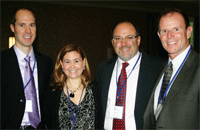What’s new in corneal procedures, dry eye and refractive surgery? The 8th Annual Educational Symposium of the Optometric Council on Refractive Technology (OCRT) discussed it all.

Moderators and presenters David Friess, O.D., Tracy Swartz, O.D., M.S., David Geffen, O.D., and Jim Owen, O.D., M.B.A., met before the start of the 8th Annual OCRT Educational Symposium.
• New Dry Eye Treatment. David Sullivan, Ph.D., President of the Tear Film and Ocular Surface Society (TFOS) and Senior Scientist at Schepens Eye Research Institute spoke on the definition, prevalence and the mechanism of dry eye disease. “There is a real problem in the treatment of dry eye. Existing treatments fail to address causative mechanics.” Dr. Sullivan pointed to the recent TFOS report on Meibomian Gland Dysfunction, which identified the importance of increased tear film osmolarity and the role of inflammation in the pathogenesis of dry eye disease. “Osmolarity is a superior marker of therapeutic efficacy,” he said. “A decrease in osmolarity shows a decrease in symptoms.”
• Topography-Guided LASIK. Topography-guided LASIK uses topography instead of a wavefront map. David Friess, O.D., presented an interim analysis of the ongoing phase III clinical trial of the myopic cohort of the study. “The interim analysis appears to have met the study objectives [for safety and effectiveness] and the results are very encouraging,” he said.
• Life After LASIK. Gene Hilmantel, O.D., of the U.S. Food & Drug Administration, talked about the LASIK Quality of Life Collaboration Project. Although no conclusive results are yet available from this ongoing study, the ultimate objective is to help patients have enough information to make an informed decision about their refractive surgery options.

